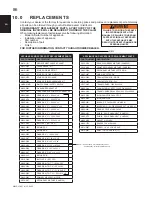
8.0 GENERAL OPERATING INSTRUCTIONS
8.1 OPERATION FOR HIGHER EFFIECIENCY AND LOWER EMISSIONS
This appliance complies with Step 1.0 For Warm Air Furnaces Under The New Source Performance Standards
(NSPS), published by the EPA in the Federal Register on March 16, 2015.
This appliance has been certi
fi
ed to CSA B415.1-10 Emission Standards and is being reviewed for compliance
with Step 1.1 or Step 1.2 of the NSPS requirements.
The heat output ranges, ef
fi
ciencies, and particulate emission rates are as follows:
WOOD FURNACE:
HMF150
HMF200
Average Particulate Emnission Rate
0.18g/Mj
0.15g/Mj
Average
Ef
fi
ciency, Delivered Heat
52%
69.63%
Delivered Heat Output Rate:
MIN 18620 Kj/hr
27549 Kj/hr
MAX 46161 Kj/hr
63345 Kj/hr
Average
Ef
fi
ciency, Overall Heat Output
72.1%
77.20%
Overall Heat Output Rate:
MIN 24930 Kj/hr
41436 Kj/hr
MAX 70871 Kj/hr
66531 Kj/hr
The stated ef
fi
ciency is based on the higher heating value of the fuel.
Results may vary from the data in the tables above based on actual installation and operating parameters
encountered.
A basic operating parameter that can dramatically affect the performance of the furnace is the type and mois-
ture content of the wood used as fuel.
To get the maximum ef
fi
ciency and lowest emission performance from your furnace consider the following
points:
•
The corner stone for running any wood
fi
red appliance is to only use split seasoned wood with low mois-
ture content. For best results split wood should be aged outdoors in a covered space for a period of at
least one year. When measured (with the moisture meter supplied with this furnace), the moisture content
of the wood should not exceed 18%.
•
Split dimensions of the wood can also play an important part in the performance of this furnace. Optimum
performance of this furnace is obtained when running the fuel in full batches (loading the
fi
rebox with a full
fuel load and not replenishing until it has burnt down to a shallow coal bed). For fuel packing and burn
time purposes the ideal length of wood is one inch shorter than the length of the
fi
rebox and a pie shaped
cross section measuring 4" to 6" (10 cm to 15 cm) wide by 6" to 8" (15 cm x 20 cm) high.
•
The energy released and overall heating capacity differs when burning hardwood or softwood. Hardwood
has a higher density than softwood and will give you more fuel by weight in the
fi
rebox. The energy con-
tent of the wood is also proportional to its weight, subsequently more energy is released by the hardwood.
•
The draft created by the furnace/chimney installation is critical to the overall heat output ef
fi
ciency and
emissions created by the appliance. Note that the length of the chimney is not only dictated by the safety
requirements of the local installation codes but by its ability to provide the right draft for optimum furnace
performance. Without adequate draft the
fi
re created can be lazy creating excessive smoke and particu-
late and not develop the heat output required. Too much draft can result in excess heat being drawn out
the chimney instead of being released into the circulation air at the heat exchangers. In extreme cases too
much draft can lead to over
fi
ring of the furnace and potential damage to property and life. The operating
draft required for this appliance is between -0.04" to -0.06" water column.
8.2 SMOKE AND CARBON MONOXIDE EMISSIONS AND MONITORS
During the combustion process the presence of smoke is a strong indicator that the fuel is not being consumed
ef
fi
ciently. Smoke is created when the combustion air supply to the fuel load is inadequate to burn all the
gases and particulate being released as the wood is consumed. This is why it is important to establish the cor-
rect draft with the furnace/chimney system. One of the bi-products of poor combustion is carbon monoxide.
W415-1506 / A / 12.04.15
71
EN






























